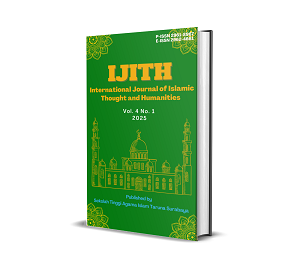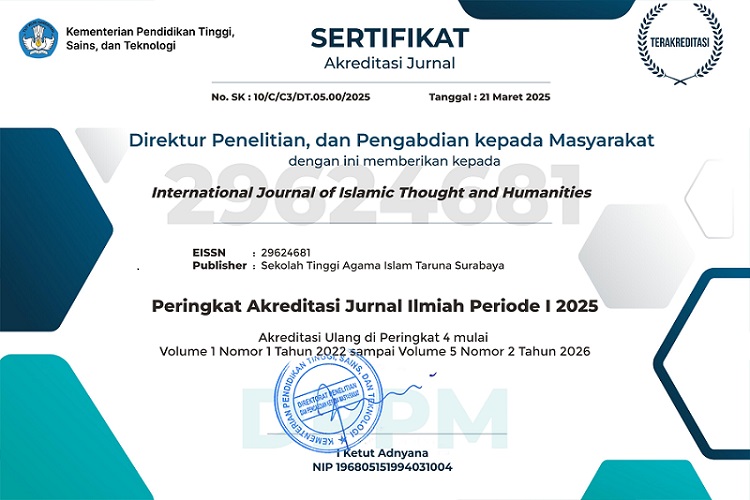Digital Da'wah and Quranic Interpretation: Opportunities, Distortions, and Ethics in the Spread of Interpretations on Social Media
DOI:
https://doi.org/10.54298/ijith.v4i1.421Keywords:
Digital Da'wah, Tafser Al-Qur'an, Social MediaAbstract
Digitalization has changed the face of Islamic preaching and dissemination of knowledge, including the interpretation of the Qur'an, which now reaches a broad audience through various social media platforms. This transformation presents significant opportunities in religious education, but also poses serious challenges in the form of distortion of meaning and oversimplification in the presentation of interpretations. This study aims to examine the dynamics of disseminating interpretations of the Qur'an on social media from three main aspects: opportunities, potential distortion, and ethics of dissemination. With a qualitative-analytical approach, this study relies on digital documentation and literature studies of interpretation content spread on platforms such as YouTube, Instagram, and TikTok. The data is reviewed in depth to understand the methodological tendencies, narratives, and scientific responsibilities in the presentation of interpretations. The results of the study show that although social media can increase accessibility and attract the interest of the younger generation in interpretations, there is a high risk of the dissemination of interpretations that do not go through proper scientific procedures, ignore the context of the verses, and pay little attention to differences in the views of scholars. In addition, ethics in disseminating interpretations are often ignored, either in the form of plagiarism, provocation, or misleading language. Therefore, this study emphasizes the importance of ethical guidelines and the active role of religious institutions in overseeing the dissemination of digital interpretation of the Qur'an so that it remains within the scientific and Sharia corridor. This study emphasizes the importance of synergy between digital innovation and the integrity of interpretation science in presenting relevant, credible, and responsible da'wah in the information era.
Downloads
References
Albana, M. Z. U. (2023). Perkembangan Pemikiran Tafsir Tradisionalis Di Indonesia. Mufham: Jurnal Ilmu Al-Qur’an Dan Tafsir, 2(2), 57–63. http://ejournal.stai-almuhajirin.ac.id/index.php/mufham/article/view/57
Anggito, A., & Setiawan, J. (2018). Metodologi Penelitian Kualitatif. CV Jejak Publisher.
Awadin, A. P., & Rusmana, D. (2023). Model Al-Qur'ān and Tafsir Models: Internalization of the Development of Digital Media. Ishlah: Jurnal Ilmu Ushuluddin, Adab Dan Dakwah, 5(2), 221–234. https://doi.org/10.32939/ishlah.v5i2.283
Azwar, S. (2014). Metode Penelitian. Pustaka Pelajar.
Erfina, S. L. (2023). Nilai-nilai Pendidikan Akhlak dalam Al-Quran (Kajian Tafsir Surat An-Nahl Ayat 90-97). ANWARUL: Jurnal Pendidikan Dan Dakwah, 3(2), 1–16. https://doi.org/10.58578/anwarul.v3i2.945
Faizah, R., & Maftuhah. (2024). Peran Media Sosial Dalam Meningkatkan Pemahaman Agama Islam Di Kalangan Generasi Milenial. Mumtaz: Jurnal Pendidikan Agama Islam, 4(1), 38–52. https://doi.org/10.69552/mumtaz.v4i1.2889
Fitriani, & Khaerani, I. F. S. R. (2021). Digitizing Website-Based Qur’anic Tafseer. Proceedings of The 1st Conference on Ushuluddin Studies, 4, 1–7. https://conferences.uinsgd.ac.id/index.php/gdcs/article/view/300
Gusmian, I. (2016). Tafsir Al-Quran Bahasa Jawa: Peneguhan Identitas, Ideologi, dan Politik Perlawanan. Suhuf, 9(1), 141–168. https://doi.org/10.22548/shf.v9i1.116
Hariyati, J. (2025). Media Sosial Sebagai Media Dakwah: Penyebaran Konten Kajian Al-Qur’an di Media Sosial dalam Perspektif Al-Qur’an. Edu Society, 5(1), 1–17. https://doi.org/10.56832/edu.v5i1.855
Kurniasih, I. (2022). Urgensi Literasi Dalam Al-Qur’an Perspektif Tafsir Maqashidi. Living Islam: Journal Of Islamic Discourses, 5(1). https://doi.org/https://doi.org/10.14421/lijid.v5i1.3113
Lukman, F. (2016). Tafsir Sosial Media Di Indonesia. Nun: Jurnal Studi Al-Qur’an Dan Tafsir Di Nusantara, 2(2), 117–139. https://doi.org/10.32495/nun.v2i2.59
Mubarak, A. Z. (2023). Genre Dakwah Digital Ustaz Hanan Attaki Di Kanal Youtube. Al-Qaul: Jurnal Dakwah Dan Komunikasi, 2(1), 14–34. https://doi.org/10.33511/alqaul.v2n1.14-34
Nirwana, A. (2024). Tafsir Digital: Revolutionizing the Interpretation of Islamic Texts (Pre-Print). SSRN, June 10. https://dx.doi.org/10.2139/ssrn.4860009
Nirwana, A., Arfan, F., & Marshal, F. D. (2024). Methods of Qur'an Research and Quran Tafseer Research: implications for contemporary Islamic Thought. Bulletin of Islamic Research, 2(1), 1–16. https://doi.org/10.69526/bir.v2i1.34
Randani, Y. N. F., Latuconsina, J. Z., & Achmad, M. (2022). Kontestasi Otoritas Agama (Studi Kasus Fenomena War di Facebook dan Instagram dan Implikasinya Terhadap Internal Umat Islam). At-Thullab : Jurnal Mahasiswa Studi Islam, 4(1), 1–15. https://doi.org/10.20885/tullab.vol4.iss1.art13
Ridwanulloh, M. W. (2023). Fenomena Matinya Kepakaran: Tantangan Dakwah di Era Digital. Prosiding Integrasi Interkoneksi Islam Dan Sains (KIIIS), 5(1), 1–10. https://ejournal.uin-suka.ac.id/saintek/kiiis/article/view/3712
Rifai, A. (2020). Tafsirweb: Digitalization of Qur’anic Interpretation and Democratization of Religious Sources in Indonesia. At-Tibyan: Jurnal Ilmu Al Qur’an Dan Tafsir, 5(2), 152–170. https://doi.org/10.32505/at-tibyan.v5i2.1640
Risdiana, A., Ramadhan, R. B., & Nawawi, I. (2020). Transformasi Dakwah Berbasis “Kitab Kuning” Ke Platform Digital. Jurnal Lektur Keagamaan, 18(1), 14–28. https://doi.org/10.31291/jlka.v18i1.682
Saihu, M., & Aziz, A. (2020). Implementasi Metode Pendidikan Pluralisme Dalam Mata Pelajaran Pendidikan Agama Islam. Belajea; Jurnal Pendidikan Islam, 5(1), 131. https://doi.org/10.29240/belajea.v5i1.1037
Saiin, A., & Karuok, M. (2023). The Concept of Sense in The Qur’an: Tazakkur, Nazara, and Tadabbur as The Basic Human Potential Towards A Superior Human Being. QiST: Journal of Quran and Tafseer Studies, 2(1), 44–62. https://doi.org/10.23917/qist.v2i1.1288
Saleh, A. S. (2007). Metodologi Tafsir Al-Qur’an Kontemporer dalam Pandangan Fazlur Rahman. Gaung Persada Press.
Soehadha, M. (2012). Metode Penelitian Sosial Kualitatif, Untuk Studi Agama. SUKA Press.
Surachmad, W. (2017). Dasar dan Teknik Research: Pengantar Metodologi Ilmiah. Tarsito.
Syafirin, M. (2024). Problematika Tafsir Sosial Dawam Rahardjo: Kritik Atas Etika dan Metodologi Penafsiran al-Quran. Al-Irfani: Journal of Al Qur’anic and Tafsir, 5(1), 1–25. https://doi.org/10.51700/irfani.v5i1.585
Tohirin. (2013). Metode Penelitian Kualitatif. Rajawali Pers.
Wahid, S. A. (2011). Studi Ulang Ilmu Al-Qur’an dan Ilmu Tafsir. Suara Muhammadiyah.
Wulandari, A. (2023). Transformasi Digitalisasi Penafsiran Al-Qur’an Masa Kini Berbasis Media Sosial. Qudwah Qur’aniyah, 1(1), 1–17. https://doi.org/10.30631/qudwahquraniyah.v1i1.1847
Yuningsih, H., & Ghany, A. (2024). Transformasi Tafsir Al-Qur’an Di Era Media Digital: Analisis Metodologi Tafsir Dalam Channel Youtube Kajian Tafsir Al-Ma’rifah. Al-Qudwah: Jurnal Studi Al-Qur’an Dan Hadis, 2(2), 1–16. http://dx.doi.org/10.24014/alqudwah.v2i2.29123
Downloads
Published
How to Cite
Issue
Section
License
Copyright (c) 2025 Pipin Armita

This work is licensed under a Creative Commons Attribution-ShareAlike 4.0 International License.
Authors who publish with this journal agree to the following terms:
- Authors retain copyright and grant the journal right of first publication with the work simultaneously licensed under a Creative Commons Attribution-ShareAlike 4.0 that allows others to share the work with an acknowledgement of the work's authorship and initial publication in this journal.
- Authors are able to enter into separate, additional contractual arrangements for the non-exclusive distribution of the journal's published version of the work (e.g., post it to an institutional repository or publish it in a book), with an acknowledgement of its initial publication in this journal.
- Authors are permitted and encouraged to post their work online (e.g., in institutional repositories or on their website) prior to and during the submission process, as it can lead to productive exchanges, as well as earlier and greater citation of published work (See The Effect of Open Access).


















